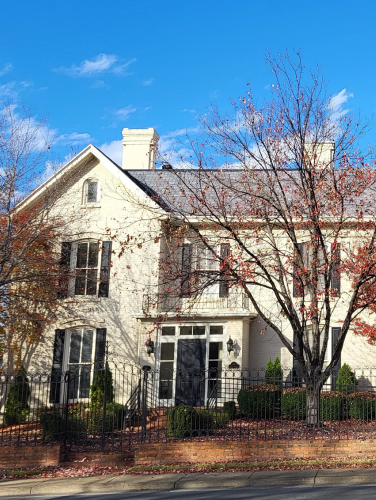
Samuel Younts House
(ca. 1873)
The home of local entrepreneur and Pineville co-founder Samuel Younts also served as a community hospital during the mid-twentieth century.
136 Main St., Pineville, NC 28134
One of the earliest residences in Pineville, the Younts House was the home of Samuel Younts (1825-1890), a successful local merchant who also served as one of Pineville’s founders and first commissioners. His Main Street general store was literally the center of town, as Pineville’s original boundaries were drawn one-half mile in each direction from his store. Younts was also a mule-trader (a lucrative business in Pineville), a cotton-broker, and a moneylender. Originally a blacksmith from Davidson County, Younts married Barbara Palmer in 1845. Following his service in the Confederate Army, Samuel and Barbara settled with their family in the area that would become Pineville. There, he quickly become the settlement’s most prosperous merchant, operating his various businesses as Samuel Younts & Son with his eldest son John A. Younts. The father-and-son team acquired numerous tracts of land in the area, including a large parcel that encompassed a substantial portion of Main Street. The Younts family also donated property and materials for the construction of the Pineville Presbyterian Church and the Pineville United Methodist Church, of which they were founding members. John continued the family business following his father’s death and served as Pineville’s mayor from 1896 to 1898. One of Samuel’s grandchildren, Paul Younts, would later become a general in the U.S. Army, Charlotte’s postmaster general, and a North Carolina state highway commissioner.
Property Quick Links
The period following the Civil War saw tremendous growth for Mecklenburg County, translating into the creation and expansion of its small towns. Fueled by the new cotton economy, these towns grew from sparsely populated outposts into thriving communities, each with its own businesses, churches, and schools. Pineville was among the first of the county’s expanding Reconstruction-era towns. Incorporated as an independent municipality in 1873, Pineville began as a small stagecoach stop called Morrow’s Turnout. With the construction of the Charlotte & South Carolina Railway in 1852, Pineville became part of the expanding network of cities and towns within the county and the state connected by rail. Although still considered small and largely rural in comparison to urban centers like Charlotte, Pineville and other Mecklenburg County towns offered close and convenient places for farmers to bring crops and for families to come together to worship, shop, and socialize with neighbors. Within ten years of its incorporation, Pineville had two drugstores, a grocer, and ten general stores—more businesses than any small Mecklenburg town other than Davidson. By 1900, Pineville was the largest of Mecklenburg’s towns, with a population of almost 600 people.
Constructed circa 1873, the Younts House stands as an early indication of the residential element emerging within the county’s small towns toward the end of the nineteenth century. The size of the Younts House, as well as its brick construction and exterior and interior details (including the elegant Italianate windows and subtle brick detailing), helped to differentiate it from rural homesteads and the more modest houses of Pineville. In 1947, the house was converted into a small community hospital by Dr. Ralph Reid (1906-1979), a Pineville native and Columbia University School of Medicine graduate who served as the town’s resident physician. The hospital remained in operation under Dr. Reid until 1967.

